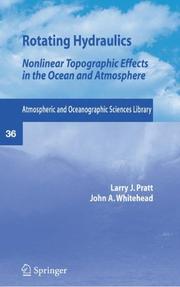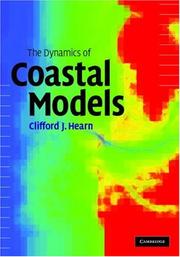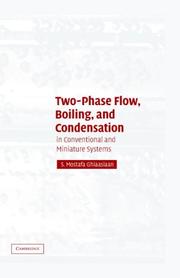| Listing 1 - 10 of 24 | << page >> |
Sort by
|

ISBN: 0387366393 038749572X 9780387366395 9780387495729 Year: 2008 Volume: 36 Publisher: New York: Springer,
Abstract | Keywords | Export | Availability | Bookmark
 Loading...
Loading...Choose an application
- Reference Manager
- EndNote
- RefWorks (Direct export to RefWorks)
Larry Pratt received his Ph. D. in physical oceanography in the Woods Hole/MIT Joint Program in 1982. He then served as a research associate and assistant research professor at the University of Rhode Island before joining the scientific staff at the Woods Hole Oceanographic Institution, where he is now a senior scientist. He is editor of The Physical Oceanography of Sea Straits and has authored or co-authored numerous articles on hydraulic effects in the ocean. J. A. (Jack) Whitehead received his Ph. D. in engineering and applied science from Yale University in 1968. After postdoctoral work and serving as assistant research geophysicist at the Institute of Geophysical and Planetary Physics at UCLA, he joined the scientific staff at the Woods Hole Oceanographic Institution, where he is now a Senior Scientist. He has authored or co-authored numerous articles on hydraulic effects in the ocean. Hydraulic effects can occur when high-speed ocean currents and atmospheric winds encounter strong topographic features. This book contains a deep and extensive discussion of geophysical flows that are broad enough to be influenced by Earth's rotation and strong enough to experience classical hydraulic effects such as critical control and hydraulic jumps. Examples include deep overflows and coastal currents in the ocean and winds in the coastal marine layer. The material is appropriate for students at the graduate or advanced undergraduate level who have some elementary knowledge of fluid mechanics. Reviews of geophysical observations and of the hydraulics of flow with no background rotation are followed by chapters on models of currents in rotating channels, shock waves and time dependence, coastal flow, two-layer stratification, and jets. Although the primary focus is on the theory, a number of case studies, including the Faroe Bank overflow and the California coastal marine layer winds, are presented along with numerous laboratory experiments. Exercises are presented at the end of most sections. The presentation should allow the reader to develop a thorough understanding of the fundamentals of the hydraulics of rotating flows.
Electronic books. -- local. --- Hydrodynamics. --- Rotating masses of fluid. --- Rotating masses of fluid --- Water masses --- Hydrodynamics --- Oceanography --- Applied Mathematics --- Marine Science --- Engineering & Applied Sciences --- Earth & Environmental Sciences --- Mathematical models --- Hydrodynamics - Mathematical models --- Oceanography - Mathematical models
Book
ISBN: 1282197002 9786612197000 3119167479 3110208288 9783110208283 3110202220 9783110202229 9781282197008 9783119167475 Year: 2008 Publisher: Berlin New York Walter de Gruyter
Abstract | Keywords | Export | Availability | Bookmark
 Loading...
Loading...Choose an application
- Reference Manager
- EndNote
- RefWorks (Direct export to RefWorks)
The authors present functional analytical methods for solving a class of partial differential equations. The results have important applications to the numerical treatment of rheology (specific examples are the behaviour of blood or print colours) and to other applications in fluid mechanics. A class of methods for solving problems in hydrodynamics is presented.
Differential equations, Nonlinear. --- Approximation theory. --- Hydrodynamics --- Theory of approximation --- Functional analysis --- Functions --- Polynomials --- Chebyshev systems --- Nonlinear differential equations --- Nonlinear theories --- Mathematical models. --- Hydrodynamics, Nonlinear Analysis.
Book
ISBN: 9789810248840 9810248849 9810248857 9789810248857 Year: 2008 Publisher: Hackensack, N.J. ; London : World Scientific,
Abstract | Keywords | Export | Availability | Bookmark
 Loading...
Loading...Choose an application
- Reference Manager
- EndNote
- RefWorks (Direct export to RefWorks)
Nonlinear waves. --- Offshore structures --- Ocean waves --- Hydrodynamics --- Mathematical models. --- Design and construction
Book
Year: 2008 Publisher: Silver Spring, MD : U.S. Dept. of Commerce, National Oceanic and Atmospheric Administration, National Ocean Service, Office of Coast Survey, Coast Survey Development Laboratory,
Abstract | Keywords | Export | Availability | Bookmark
 Loading...
Loading...Choose an application
- Reference Manager
- EndNote
- RefWorks (Direct export to RefWorks)
Hydrodynamics --- Water levels --- Water temperature --- Water currents --- Mathematical models --- Research --- Evaluation. --- Forecasting --- Mathematical models.
Book
Year: 2008 Publisher: [Silver Spring, Md.] : U.S. Dept. of Commerce, National Oceanic and Atmospheric Administration, National Ocean Service, Office of Coast Survey, Coast Survey Development Laboratory,
Abstract | Keywords | Export | Availability | Bookmark
 Loading...
Loading...Choose an application
- Reference Manager
- EndNote
- RefWorks (Direct export to RefWorks)
Tides --- Hydrographic surveying --- Numerical grid generation (Numerical analysis) --- Hydrodynamics --- Computer simulation. --- Mathematical models.
Book
ISBN: 0939773651 9780939773657 Year: 2008 Publisher: Jersey City, N.J. : Society of Naval Architects and Marine Engineers,
Abstract | Keywords | Export | Availability | Bookmark
 Loading...
Loading...Choose an application
- Reference Manager
- EndNote
- RefWorks (Direct export to RefWorks)
Propellers. --- Ship propulsion --- Ships --- Hélices marines. --- Navires --- Hydrodynamics --- Propulsion. --- Hydrodynamique. --- Hélices marines.
Book
ISBN: 9782100515288 Year: 2008 Publisher: Paris : Dunod,
Abstract | Keywords | Export | Availability | Bookmark
 Loading...
Loading...Choose an application
- Reference Manager
- EndNote
- RefWorks (Direct export to RefWorks)
Hydrogeology --- Surface water --- groundwater --- Hydrodynamics --- Water quality --- Groundwater table --- Water resources --- Civil engineering

ISBN: 9780521807401 0521807409 9780511619588 9780521001984 9780511394485 0511394489 0511393830 9780511393839 0511619588 9780511391699 1107174317 1281370258 9786611370251 0511393008 0511391692 0511390521 Year: 2008 Publisher: Cambridge Cambridge University Press
Abstract | Keywords | Export | Availability | Bookmark
 Loading...
Loading...Choose an application
- Reference Manager
- EndNote
- RefWorks (Direct export to RefWorks)
Coastal basins are defined as estuaries, lagoons, and embayments. This book deals with the science of coastal basins using simple models, many of which are presented in either analytical form or Microsoft Excel or MATLAB. The book introduces simple hydrodynamics and its applications, from the use of simple box and one-dimensional models to flow over coral reefs. The book also emphasizes models as a scientific tool in our understanding of coasts, and introduces the value of the most modern flexible mesh combined wave-current models. Examples from shallow basins around the world illustrate the wonders of the scientific method and the power of simple dynamics. This book is ideal for use as an advanced textbook for graduate students and as an introduction to the topic for researchers, especially those from other fields of science needing a basic understanding of the basic ideas of the dynamics of coastal basins.
Coasts --- Hydrodynamics --- Estuaries --- Mathematical models --- Hydrodynamics. --- Branching bays --- Drowned river mouths --- Firths --- River estuaries --- Rivers --- Coastal landforms --- Coastal zones --- Coastlines --- Landforms --- Seashore --- Fluid dynamics --- Mathematical models. --- Coasts - Mathematical models --- Estuaries - Mathematical models

ISBN: 9780521882767 0521882761 9780511619410 9781107431638 Year: 2008 Publisher: New York Cambridge University Press
Abstract | Keywords | Export | Availability | Bookmark
 Loading...
Loading...Choose an application
- Reference Manager
- EndNote
- RefWorks (Direct export to RefWorks)
Fluid dynamics. --- Two-phase flow. --- Fluid dynamics --- Two-phase flow --- 532.5 --- Flow, Two-phase --- Multiphase flow --- Dynamics --- Fluid mechanics --- 532.5 Liquid motion. Hydrodynamics --- Liquid motion. Hydrodynamics --- Fluides, Dynamique des --- Écoulement diphasique
Book
Year: 2008 Publisher: Silver Spring, Md. : U.S. Dept. of Commerce, National Oceanic and Atmospheric Administration, National Ocean Service, Office of Coast Survey, Coast Survey Development Laboratory,
Abstract | Keywords | Export | Availability | Bookmark
 Loading...
Loading...Choose an application
- Reference Manager
- EndNote
- RefWorks (Direct export to RefWorks)
Tides --- Ocean surface topography --- Hydrographic surveying --- Numerical grid generation (Numerical analysis) --- Hydrodynamics --- Measurement. --- Mathematical models. --- Computer simulation.
| Listing 1 - 10 of 24 | << page >> |
Sort by
|

 Search
Search Feedback
Feedback About UniCat
About UniCat  Help
Help News
News